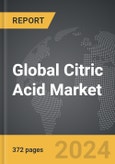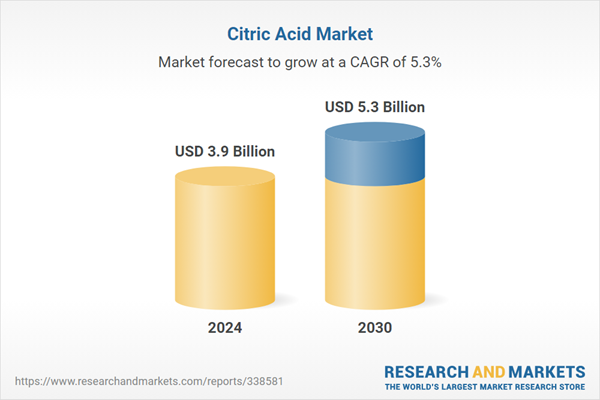Global Citric Acid Market - Key Trends & Drivers Summarized
Citric acid is a naturally occurring organic acid found in citrus fruits, and it is widely used in various industries due to its versatile properties. In the food and beverage industry, citric acid is commonly used as a preservative, flavoring agent, and acidulant to enhance the taste and stability of products such as soft drinks, candies, and canned foods. Its chelating properties make it valuable in cleaning and detergents, where it helps remove limescale and improve the effectiveness of cleaning agents. Citric acid is also utilized in the pharmaceutical and cosmetics industries, serving as a pH adjuster, antioxidant, and active ingredient in skincare products.The production of citric acid is primarily achieved through the fermentation of sugar substrates by the mold Aspergillus niger. Advances in fermentation technology and microbial strain development have increased the efficiency and yield of citric acid production, making it more cost-effective and environmentally friendly. The demand for citric acid is rising due to its natural origin and biodegradability, which align with the growing consumer preference for eco-friendly and sustainable products. Additionally, regulatory approvals for citric acid as a safe food additive and its extensive use in a variety of applications are driving market growth.
The growth in the citric acid market is driven by several factors. Firstly, the increasing demand for natural and clean-label ingredients in the food and beverage industry is boosting the use of citric acid as a preservative and flavoring agent. Secondly, advancements in fermentation technology and microbial strain improvement are enhancing the production efficiency and cost-effectiveness of citric acid. Thirdly, the expanding applications of citric acid in pharmaceuticals, cosmetics, and cleaning products are contributing to its market growth. Lastly, the shift towards environmentally friendly and sustainable products is driving the adoption of biodegradable and non-toxic citric acid in various industries. These factors collectively contribute to the robust growth of the citric acid market.
Report Scope
The report analyzes the Citric Acid market, presented in terms of market value (USD). The analysis covers the key segments and geographic regions outlined below.- Segments: Form (Powder, Liquid); Application (Food & Beverage, Pharmaceuticals, Other Applications).
- Geographic Regions/Countries: World; USA; Canada; Japan; China; Europe; France; Germany; Italy; UK; Spain; Russia; Rest of Europe; Asia-Pacific; Australia; India; South Korea; Rest of Asia-Pacific; Latin America; Argentina; Brazil; Mexico; Rest of Latin America; Middle East; Iran; Israel; Saudi Arabia; UAE; Rest of Middle East; Africa.
Key Insights:
- Market Growth: Understand the significant growth trajectory of the Powder Form segment, which is expected to reach US$3.1 Billion by 2030 with a CAGR of 5.2%. The Liquid Form segment is also set to grow at 5.5% CAGR over the analysis period.
- Regional Analysis: Gain insights into the U.S. market, valued at $1.2 Billion in 2024, and China, forecasted to grow at an impressive 7.8% CAGR to reach $505.7 Million by 2030. Discover growth trends in other key regions, including Japan, Canada, Germany, and the Asia-Pacific.
Why You Should Buy This Report:
- Detailed Market Analysis: Access a thorough analysis of the Global Citric Acid Market, covering all major geographic regions and market segments.
- Competitive Insights: Get an overview of the competitive landscape, including the market presence of major players across different geographies.
- Future Trends and Drivers: Understand the key trends and drivers shaping the future of the Global Citric Acid Market.
- Actionable Insights: Benefit from actionable insights that can help you identify new revenue opportunities and make strategic business decisions.
Key Questions Answered:
- How is the Global Citric Acid Market expected to evolve by 2030?
- What are the main drivers and restraints affecting the market?
- Which market segments will grow the most over the forecast period?
- How will market shares for different regions and segments change by 2030?
- Who are the leading players in the market, and what are their prospects?
Report Features:
- Comprehensive Market Data: Independent analysis of annual sales and market forecasts in US$ Million from 2024 to 2030.
- In-Depth Regional Analysis: Detailed insights into key markets, including the U.S., China, Japan, Canada, Europe, Asia-Pacific, Latin America, Middle East, and Africa.
- Company Profiles: Coverage of players such as Cargill, Inc., Archer Daniels Midland Company, Balchem Corporation, Fuso Chemical Co., Ltd., International Flavors & Fragrances, Inc. and more.
- Complimentary Updates: Receive free report updates for one year to keep you informed of the latest market developments.
Some of the 47 companies featured in this Citric Acid market report include:
- Cargill, Inc.
- Archer Daniels Midland Company
- Balchem Corporation
- Fuso Chemical Co., Ltd.
- International Flavors & Fragrances, Inc.
- Jungbunzlauer Suisse AG
- COFCO Group
- Gadot Biochemical Industries Ltd.
- Foodchem International Corporation
- Hawkins, Inc.
- Huangshi Xinghua Biochemical Co. Ltd.
- BBCA Group
- Chemelco International B.V.
- Anmol Chemicals Group
- Dr. Paul Lohmann GmbH KG
This edition integrates the latest global trade and economic shifts into comprehensive market analysis. Key updates include:
- Tariff and Trade Impact: Insights into global tariff negotiations across 180+ countries, with analysis of supply chain turbulence, sourcing disruptions, and geographic realignment. Special focus on 2025 as a pivotal year for trade tensions, including updated perspectives on the Trump-era tariffs.
- Adjusted Forecasts and Analytics: Revised global and regional market forecasts through 2030, incorporating tariff effects, economic uncertainty, and structural changes in globalization. Includes historical analysis from 2015 to 2023.
- Strategic Market Dynamics: Evaluation of revised market prospects, regional outlooks, and key economic indicators such as population and urbanization trends.
- Innovation & Technology Trends: Latest developments in product and process innovation, emerging technologies, and key industry drivers shaping the competitive landscape.
- Competitive Intelligence: Updated global market share estimates for 2025, competitive positioning of major players (Strong/Active/Niche/Trivial), and refined focus on leading global brands and core players.
- Expert Insight & Commentary: Strategic analysis from economists, trade experts, and domain specialists to contextualize market shifts and identify emerging opportunities.
Table of Contents
Companies Mentioned (Partial List)
A selection of companies mentioned in this report includes, but is not limited to:
- Cargill, Inc.
- Archer Daniels Midland Company
- Balchem Corporation
- Fuso Chemical Co., Ltd.
- International Flavors & Fragrances, Inc.
- Jungbunzlauer Suisse AG
- COFCO Group
- Gadot Biochemical Industries Ltd.
- Foodchem International Corporation
- Hawkins, Inc.
- Huangshi Xinghua Biochemical Co. Ltd.
- BBCA Group
- Chemelco International B.V.
- Anmol Chemicals Group
- Dr. Paul Lohmann GmbH KG
Table Information
| Report Attribute | Details |
|---|---|
| No. of Pages | 281 |
| Published | December 2025 |
| Forecast Period | 2024 - 2030 |
| Estimated Market Value ( USD | $ 3.9 Billion |
| Forecasted Market Value ( USD | $ 5.3 Billion |
| Compound Annual Growth Rate | 5.3% |
| Regions Covered | Global |









